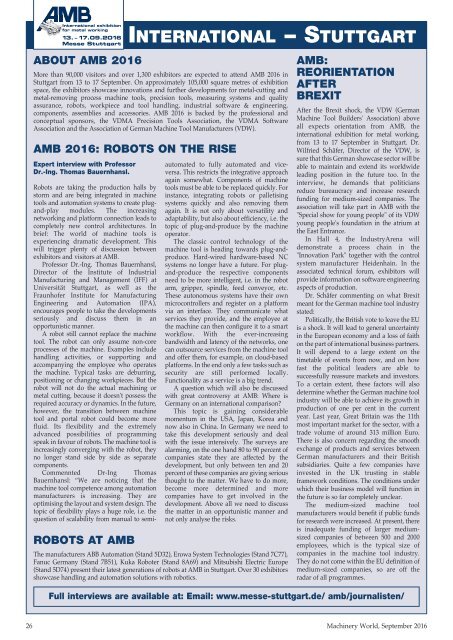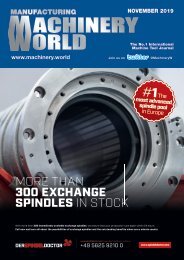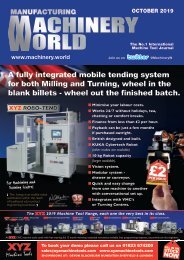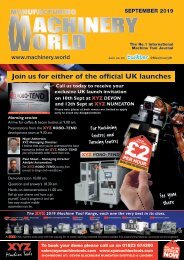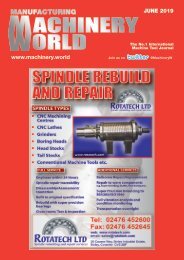Machinery World - September 2016
You also want an ePaper? Increase the reach of your titles
YUMPU automatically turns print PDFs into web optimized ePapers that Google loves.
ABOUT AMB <strong>2016</strong><br />
INTERNATIONAL –STUTTGART<br />
More than 90,000 visitors and over 1,300 exhibitors are expected to attend AMB <strong>2016</strong> in<br />
Stuttgart from 13 to 17 <strong>September</strong>. On approximately 105,000 square metres of exhibition<br />
space, the exhibitors showcase innovations and further developments for metal-cutting and<br />
metal-removing process machine tools, precision tools, measuring systems and quality<br />
assurance, robots, workpiece and tool handling, industrial software & engineering,<br />
components, assemblies and accessories. AMB <strong>2016</strong> is backed by the professional and<br />
conceptual sponsors, the VDMA Precision Tools Association, the VDMA Software<br />
Association and the Association of German Machine Tool Manufacturers (VDW).<br />
AMB <strong>2016</strong>: ROBOTS ON THE RISE<br />
Expert interview with Professor<br />
Dr.-Ing. Thomas Bauernhansl.<br />
ROBOTS AT AMB<br />
Robots are taking the production halls by<br />
storm and are being integrated in machine<br />
tools and automation systems to create plugand-play<br />
modules. The increasing<br />
networking and platform connection leads to<br />
completely new control architectures. In<br />
brief: The world of machine tools is<br />
experiencing dramatic development. This<br />
will trigger plenty of discussion between<br />
exhibitors and visitors at AMB.<br />
Professor Dr.-Ing. Thomas Bauernhansl,<br />
Director of the Institute of Industrial<br />
Manufacturing and Management (IFF) at<br />
Universität Stuttgart, as well as the<br />
Fraunhofer Institute for Manufacturing<br />
Engineering and Automation (IPA),<br />
encourages people to take the developments<br />
seriously and discuss them in an<br />
opportunistic manner.<br />
A robot still cannot replace the machine<br />
tool. The robot can only assume non-core<br />
processes of the machine. Examples include<br />
handling activities, or supporting and<br />
accompanying the employee who operates<br />
the machine. Typical tasks are deburring,<br />
positioning or changing workpieces. But the<br />
robot will not do the actual machining or<br />
metal cutting, because it doesn't possess the<br />
required accuracy or dynamics. In the future,<br />
however, the transition between machine<br />
tool and portal robot could become more<br />
fluid. Its flexibility and the extremely<br />
advanced possibilities of programming<br />
speak in favour of robots. The machine tool is<br />
increasingly converging with the robot, they<br />
no longer stand side by side as separate<br />
components.<br />
Commennted Dr-Ing Thomas<br />
Bauernhansl: “We are noticing that the<br />
machine tool competence among automation<br />
manufacturers is increasing. They are<br />
optimising the layout and system design. The<br />
topic of flexibility plays a huge role, i.e. the<br />
question of scalability from manual to semiautomated<br />
to fully automated and viceversa.<br />
This restricts the integrative approach<br />
again somewhat. Components of machine<br />
tools must be able to be replaced quickly. For<br />
instance, integrating robots or palletising<br />
systems quickly and also removing them<br />
again. It is not only about versatility and<br />
adaptability, but also about efficiency, i.e. the<br />
topic of plug-and-produce by the machine<br />
operator.<br />
The classic control technology of the<br />
machine tool is heading towards plug-andproduce.<br />
Hard-wired hardware-based NC<br />
systems no longer have a future. For plugand-produce<br />
the respective components<br />
need to be more intelligent, i.e. in the robot<br />
arm, gripper, spindle, feed conveyor, etc.<br />
These autonomous systems have their own<br />
microcontrollers and register on a platform<br />
via an interface. They communicate what<br />
services they provide, and the employee at<br />
the machine can then configure it to a smart<br />
workflow. With the ever-increasing<br />
bandwidth and latency of the networks, one<br />
can outsource services from the machine tool<br />
and offer them, for example, on cloud-based<br />
platforms. In the end only a few tasks such as<br />
security are still performed locally.<br />
Functionality as a service is a big trend.<br />
A question which will also be discussed<br />
with great controversy at AMB: Where is<br />
Germany on an international comparison?<br />
This topic is gaining considerable<br />
momentum in the USA, Japan, Korea and<br />
now also in China. In Germany we need to<br />
take this development seriously and deal<br />
with the issue intensively. The surveys are<br />
alarming, on the one hand 80 to 90 percent of<br />
companies state they are affected by the<br />
development, but only between ten and 20<br />
percent of these companies are giving serious<br />
thought to the matter. We have to do more,<br />
become more determined and more<br />
companies have to get involved in the<br />
development. Above all we need to discuss<br />
the matter in an opportunistic manner and<br />
not only analyse the risks.<br />
The manufacturers ABB Automation (Stand 5D32), Erowa System Technologies (Stand 7C77),<br />
Fanuc Germany (Stand 7B51), Kuka Roboter (Stand 8A69) and Mitsubishi Electric Europe<br />
(Stand 5D74) present their latest generations of robots at AMB in Stuttgart. Over 30 exhibitors<br />
showcase handling and automation solutions with robotics.<br />
AMB:<br />
REORIENTATION<br />
AFTER<br />
BREXIT<br />
After the Brexit shock, the VDW (German<br />
Machine Tool Builders' Association) above<br />
all expects orientation from AMB, the<br />
international exhibition for metal working,<br />
from 13 to 17 <strong>September</strong> in Stuttgart. Dr.<br />
Wilfried Schäfer, Director of the VDW, is<br />
sure that this German showcase sector will be<br />
able to maintain and extend its worldwide<br />
leading position in the future too. In the<br />
interview, he demands that politicians<br />
reduce bureaucracy and increase research<br />
funding for medium-sized companies. The<br />
association will take part in AMB with the<br />
"Special show for young people" of its VDW<br />
young people's foundation in the atrium at<br />
the East Entrance.<br />
In Hall 4, the IndustryArena will<br />
demonstrate a process chain in the<br />
"Innovation Park" together with the control<br />
system manufacturer Heidenhain. In the<br />
associated technical forum, exhibitors will<br />
provide information on software engineering<br />
aspects of production.<br />
Dr. Schäfer commenting on what Brexit<br />
meant for the German machine tool industry<br />
stated:<br />
Politically, the British vote to leave the EU<br />
is a shock. It will lead to general uncertainty<br />
in the European economy and a loss of faith<br />
on the part of international business partners.<br />
It will depend to a large extent on the<br />
timetable of events from now, and on how<br />
fast the political leaders are able to<br />
successfully reassure markets and investors.<br />
To a certain extent, these factors will also<br />
determine whether the German machine tool<br />
industry will be able to achieve its growth in<br />
production of one per cent in the current<br />
year. Last year, Great Britain was the 11th<br />
most important market for the sector, with a<br />
trade volume of around 313 million Euro.<br />
There is also concern regarding the smooth<br />
exchange of products and services between<br />
German manufacturers and their British<br />
subsidiaries. Quite a few companies have<br />
invested in the UK trusting in stable<br />
framework conditions. The conditions under<br />
which their business model will function in<br />
the future is so far completely unclear.<br />
The medium-sized machine tool<br />
manufacturers would benefit if public funds<br />
for research were increased. At present, there<br />
is inadequate funding of larger mediumsized<br />
companies of between 500 and 2000<br />
employees, which is the typical size of<br />
companies in the machine tool industry.<br />
They do not come within the EU definition of<br />
medium-sized companies, so are off the<br />
radar of all programmes.<br />
Full interviews are available at: Email: www.messe-stuttgart.de/ amb/journalisten/<br />
26 <strong>Machinery</strong> <strong>World</strong>, <strong>September</strong> <strong>2016</strong>


